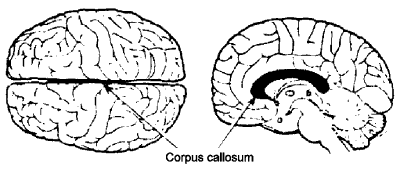 |
Science Frontiers ONLINE No. 13: Winter 1981 |
|
|
Half A Brain Sometimes Better Than A Whole One
The orthodox view of the human brain holds that the left or dominant half governs the right side of the body and is concerned with logical thought, verbal analysis, etc. The right side of the brain controls the left side of the body and is responsible for spatial and intuitive thinking. The right side supposed-ly cannot even participate in verbal expression. The two halves of the brain are connected by the corpus callosum. That this interconnection sometimes creates problems is evident from the fact that its severance often leads to dramatic improvement in some types of epilepsy. These split-brain individuals, however, must contend with such bizarre situations as not being able to verbally identify objects seen or felt by the left eye and hand, even though they know what the objects are.
Such situations merely confirm the orthodox view of the brain. But when half of the brain is completely removed, the conventional picture of the brain is upset. In one case, a woman with partial paralysis and frequent epileptic seizures had the left side of her brain removed. Her seizures and paralysis disappeared permanently; even more, her personality improved markedly. The half of the brain that remained assumed all brain functions and performed them better than the complete brain had. Conclusion: each half of the human brain has the intrinsic capability of operating as a whole brain despite the usual specialization of the halves.
(Gooch, Stan; "Right Brain, Left Brain," New Scientist, 87:790, 1980.)
